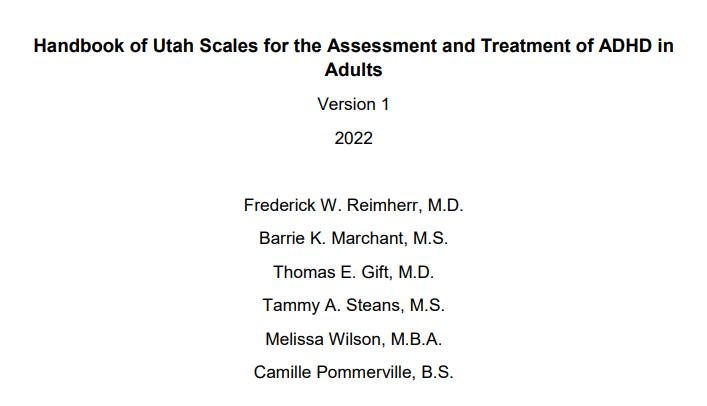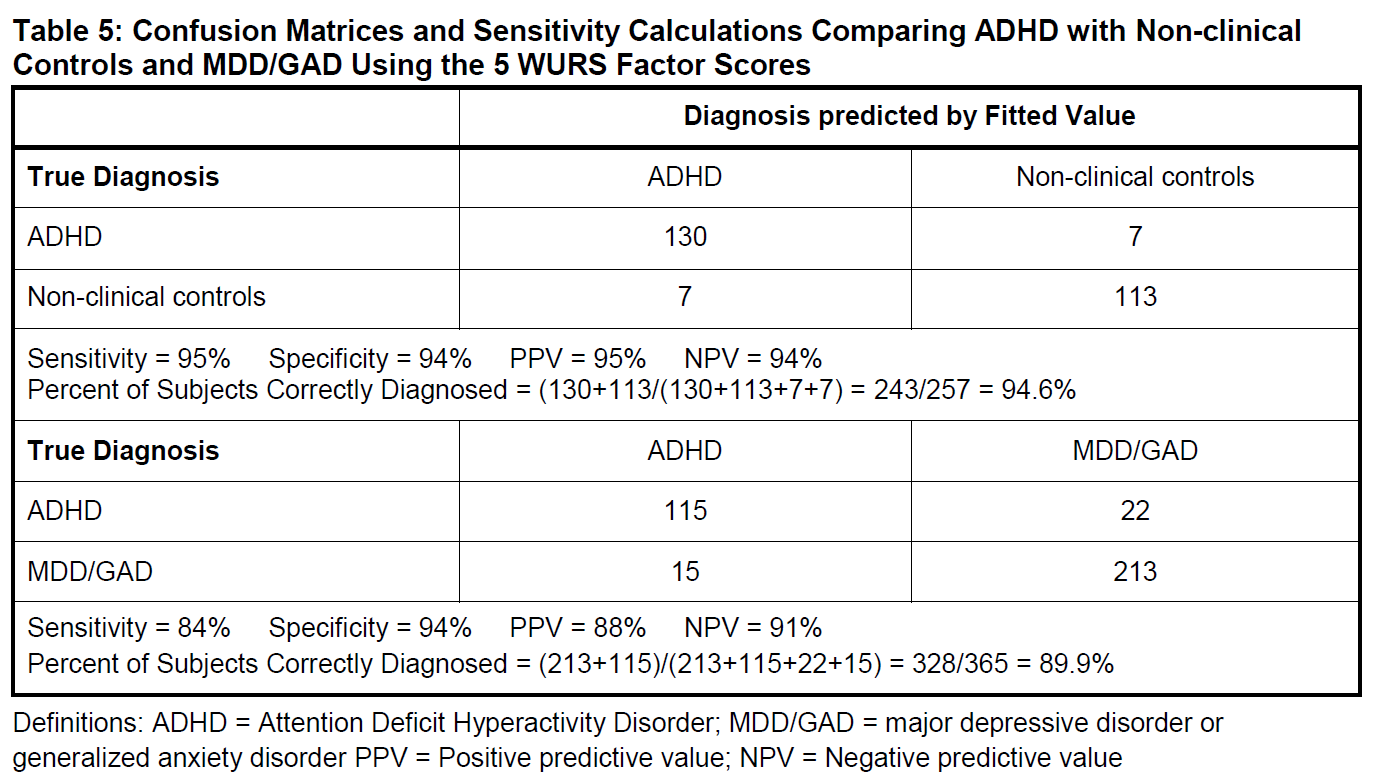- Home
- Wender Utah Rating Scale
Wender Utah Rating Scale Handbook
June 21, 2024 – The Wender Utah Rating Scale Handbook succinctly summarizes research, describes different Wender Utah Rating Scale (WURS) forms, explains scoring, and helps with interpretation.
On this page ...
- Wender Utah Rating Scale Handbook - Download.
- Copyright? - how is the WURS Handbook licensed?
- Citation for the Handbook (AMA, APA, & Chicago citation styles).
- Researcher? - who you should you contact if conducting WURS research.
- WURS Scorer (25, 45, 61)
- WURS Manual - Wender Utah Rating Scale Handbook - image of front cover and a download link.
- WURS Manual Excerpt - from the introduction.
- Download the WURS Handbook (Manual).
- Comment (or ask a question)
I provide additional information about WURS scoring and interpretation on this page:
→ Wender Utah Rating Scale Scoring
Wender Utah Rating Scale Handbook - Download
→ Click here to download the Wender Utah Rating Scale Handbook.
You can also access this Wender Utah Rating Scale manual at perma.cc/F4VS-TMU5.
Copyright?
The WURS Handbook is licensed under CC BY-NC-ND 4.0 (Attribution-NonCommercial-NoDerivs 4.0 International).
Please read about what that means on the Creative Commons website.
Citation
Chicago citation style:
Reimherr, Frederick W., Barrie K. Marchant, Thomas E. Gift, Tammy A. Steans, Melissa Wilson, and Camille Pommerville. Handbook of Utah Scales for the Assessment and Treatment of ADHD in Adults. 2022. https://perma.cc/F4VS-TMU5.
APA citation style:
Reimherr, F. W., Marchant, B. K., Gift, T. E., Steans, T. A., Wilson, M., & Pommerville, C. (2022). Handbook of Utah Scales for the Assessment and Treatment of ADHD in Adults. https://perma.cc/F4VS-TMU5.
AMA citation style:
Reimherr FW, Marchant BK, Gift TE, Steans TA, Wilson M, Pommerville C. Handbook of Utah Scales for the Assessment and Treatment of ADHD in Adults. 2022. https://perma.cc/F4VS-TMU5.
Note: Perma.cc is a permanent link service developed by the Library Innovation Lab at Harvard University.
Researcher?
If you are a physician, psychologist, or other scientific investigator interested in conducting research on the Wender Utah Rating Scale (WURS), I encourage you to contact one of the leading WURS researchers for consultation or to answer questions:
BARRIE K MARCHANT
611 N 26TH ST
LINCOLN NE 68503-3030
email: barriemarchant[at]aol[dot]com
WURS Scorer (25, 45, 61)
Michelle Chan with Bridge Psychologists (Adelaide, South Australia), made an Excel spreadsheet that automatically calculates:
- WURS-25 score (for WURS-25, 45, or 61);
- Factor scores (for WURS-45 or WURS-61); and
- Fitted values (for WURS-45 or WURS-61).
→ Download WURS (25, 45, 61) Scorer ←
→ This is a zipped folder for technical reasons. The spreadsheet is inside the folder. The folder URL is:
https://www.drworthen.net/support-files/wurs-scorer.zip
→ There should be only one file in the folder:
WURS-Scorer(25, 45, 61).xlsx
→ How to Open a Zip File: 4 Easy Step-by-Step Methods (WikiHow.com)
Note: You must enter the item responses from a WURS completed by your patient or client.
** Thank you to Michelle for sharing this WURS-25, WURS-45, WURS-61 scoring spreadsheet!
WURS Manual - Wender Utah Rating Scale Handbook
 Wender Utah Rating Scale Handbook title page (image)
Wender Utah Rating Scale Handbook title page (image)→ Click here to download the Wender Utah Rating Scale Handbook.
- - - - -
I provide additional information about WURS scoring and interpretation on this page:
→ Wender Utah Rating Scale Scoring
WURS Manual Excerpt
Wender Utah Rating Scale Handbook - excerpt
A - Introduction Background
In 1972 researchers at Washington University in St Louis published the Research Diagnostic Criteria in the Archives of General Psychiatry (Feighner et al. 1972) and then in 1974 the seminal monograph, Psychiatric Diagnosis (Woodruff, Goodwin & Gauze 1974). They argued for explicit criteria for the diagnosis of psychiatric patients which represented a turning point for psychiatry and laid the groundwork for the development of DSM-III.
In Utah in the 1970’s, we pursued a similar course by identifying a group of patients in a community mental health clinic who presented with a variety of social problems and emotional symptoms along with a childhood history consistent with ADHD. The prevailing wisdom at the time was that ADHD was a childhood disorder which mysteriously disappeared with entrance into adulthood. Following in the spirit of Washington University research, we started to validate the childhood diagnosis of ADHD in these now adult patients. In a first step, we attempted to show that our suspected adult ADHD patients did in fact have a childhood history of ADHD based on their report of childhood problems and using the Connors’ Brief Parent Rating Scale completed by their parents.
B – Wender Utah Rating Scale (WURS)
Among ADHD assessment instruments the WURS has had a unique position documenting childhood signs and symptoms which suggest a now adult patient had a childhood history of ADHD.
Two aspects of the scale deserve special attention. First, we published the scale without restrictions, which encouraged use of the scale. This was highly successful as indicated by over 5,000 citations in Google Scholar. Second, the scale allowed an examination of the adult conditions more generally associated with a childhood history of ADHD.
Collectively, these papers have reported on clinical use of the scale and its psychometric properties. Most papers have been highly supportive of the use of the scale, although some papers have raised concerns about the lack of diagnostic specificity of both high and low scores on the WURS.
In arriving at a psychiatric diagnosis, a score provided by a standardized instrument cannot be regarded as definitive, and this is true of the WURS in determining the presence or absence of ADHD.
In an effort to avoid confusion, we will refer to the original version of the Wender Utah Rating Scale as the “WURS-61” or the WURS. In presenting alternative versions of the scale, we will always refer to them with a number attached as either the Wender Utah Rating Scale-25 or the Wender Utah Rating Scale-45; both can also be abbreviated as the WURS-25 or the WURS-45.
Turning to the utility of the various versions, for typical clinical practice the WURS-25 categorized version is quick and convenient for both the patient and clinician. In this version similar symptoms are grouped under a heading or category name. This allows easy scoring of the WURS-25 and its 3 factors. Scoring the WURS-25 using its 3 factors improves the scale’s sensitivity relative to the simple item total and also provides a more complete clinical picture of the patient’s childhood.
For research purposes or more demanding clinical situations, the WURS-45 categorized version, improves the scale’s psychometric performance with little additional effort. In addition, its five factor scores provide a more comprehensive understanding of the patient.
The original WURS-61 items allows scoring to produce scores for all versions of the instrument. It is more time consuming for patients and those doing the scoring. Also the factors are less convincing since the item loadings tend to be lower than with the WURS-45. Further, efficacy as manifested by the AUC statistics for the two versions is virtually identical. In a sample of 137 ADHD patients and 228 MDD/GAD patients the WURS-61 correctly identified only 7 more subjects than the WURS-45.
For scoring convenience we have provided versions categorized into factors for all three versions. The convenience of using forms with the items categorized must be balanced against the possibility that patients are responding more to category headings rather than to the individual items.
Download the WURS Handbook (Manual)
→ Click here to download the Wender Utah Rating Scale Handbook.
This WURS Handbook is licensed under CC BY- 4.0 which means you are free to copy and redistribute this Handbook in any medium or format, provided you give appropriate credit, provide a link to the license, and do not charge for its use for commercial purposes.
 WURS-61 Classification Accuracy using Factor Scores (from the Handbook, p. 13)
WURS-61 Classification Accuracy using Factor Scores (from the Handbook, p. 13)What Do You Think?
I value your feedback!
If you would like to comment, ask questions, or offer suggestions about this page, please feel free to do so. Of course, keep it clean and courteous.
You can leave an anonymous comment if you wish–just type your first name.
If you want to receive an email when someone replies to your comment, click the icon on the lower right of the comment box to use Google Sign-in. (Your email remains private.)
Important: Do not type your email address or other identifying information into your comment as it will appear on the Internet for everyone to see ... and for spam bots to harvest so that spammers can sell your email address to other spammers.
How did you build this website?
I used Solo Build It! to build this website in 2004 and still use it today, especially for the extremely helpful business guidance and the superior search engine optimization.
Note: If you click on one of these links and you decide to purchase Solo Build It! I earn a small affiliate commission. Your cost is the same either way. If you do not want me to earn an affiliate commission, just google "solo build it".



